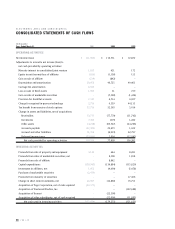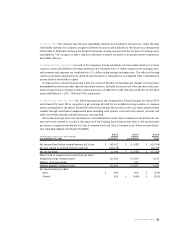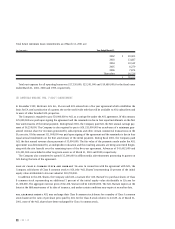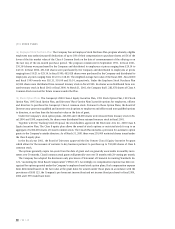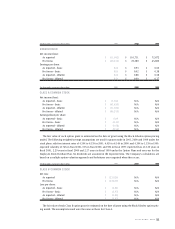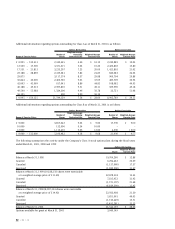Electronic Arts 2001 Annual Report Download - page 49
Download and view the complete annual report
Please find page 49 of the 2001 Electronic Arts annual report below. You can navigate through the pages in the report by either clicking on the pages listed below, or by using the keyword search tool below to find specific information within the annual report.
ELECTRONIC ARTS
47
(c) Foreign Currency Forward Exchange Contracts
The Company utilizes foreign exchange contracts to hedge for-
eign currency exposures of underlying assets and liabilities, primarily certain intercompany receivables that are
denominated in foreign currencies, thereby limiting our risk. The Company does not use forward exchange contracts
for speculative or trading purposes. The Company’s accounting policies for these instruments are based on the
Company’s designation of such instruments as hedging transactions. The criteria the Company uses for designat-
ing an instrument as a hedge include the instrument’s effectiveness in risk reduction and one-to-one matching of
forward exchange contracts to underlying transactions. Gains and losses on currency forward contracts that are
designated and effective as hedges of existing transactions are recognized in income in the same period as losses
and gains on the underlying transactions are recognized and generally offset. Gains and losses on currency forward
contracts that are designated and effective as hedges of firm commitments are deferred and recognized in income
in the same period that the underlying transactions are settled. Gains and losses on any instruments not meeting
the above criteria would be recognized in income in the current period. The Company transacts business in various
foreign currencies. At March 31, 2001, the Company had foreign exchange contracts, all with maturities of less
than seven months, to purchase and sell approximately $279,415,000 in foreign currencies, primarily in British
Pounds, Euro, Canadian Dollars, Japanese Yen and other European currencies.
Fair value represents the difference in value of the contracts at the spot rate and the forward rate, plus the
unamortized premium or discount. At March 31, 2001, fair value of these contracts is $4,825,000. The counterpar-
ties to these contracts are substantial and creditworthy multinational commercial banks. The risks of counterparty
nonperformance associated with these contracts are not considered to be material. Notwithstanding our efforts to
manage foreign exchange risk, there can be no assurances that our hedging activities will adequately protect us
against the risks associated with foreign currency fluctuations.
(4) COMMITMENTS
The Company leases certain of its current facilities and certain equipment under non-cancelable capital and oper-
ating lease agreements. The Company is required to pay property taxes, insurance and normal maintenance costs
for certain of its facilities and will be required to pay any increases over the base year of these expenses on the
remainder of the Company’s facilities.
In February 1995, the Company entered into a master operating lease, as subsequently amended, for the pur-
chase of land and construction of three buildings and a parking structure in Redwood City, California. The initial
term of the lease is for a period of three years from November 30, 1998. Monthly lease payments are based upon
the London InterBank Offered Rate. The Company has the option to purchase the property for the unamortized
financed balance at any time after the non-cancelable lease term, or it may terminate the lease at any time after the
non-cancelable term by arranging a third party sale or by making a termination payment. Should the Company
elect to terminate the lease, it will guarantee a residual value of up to 85% of the unamortized value of the property.
As part of the agreement, the Company must also comply with certain financial covenants.
In December 2000, the Company entered into a second operating lease for the construction and occupation of
two buildings and a parking structure to be constructed in Redwood City, California. The initial term of the lease is
for a period of five years from December 8, 2000. Monthly lease payments are based upon the Commercial Paper
Rate and the London InterBank Offered Rate. The Company has the option to purchase the property for the
unamortized financed balance at any time after the non-cancelable lease term, or it may terminate the lease at any
time after the non-cancelable term by arranging a third party sale or by making a termination payment. Should the
Company elect to terminate the lease, it will guarantee a residual value of up to 85% of the unamortized value of
the property. As part of the agreement, the Company must also comply with certain financial covenants.



